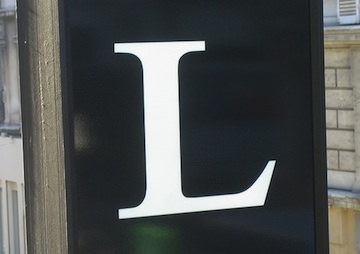The Insider’s Economic Dictionary: L Is for Land
Labor capitalism: A term popularized by Margaret Thatcher to describe an economy in which workers became shareholders but not managers. Labor’s role is that of the exploited party, not the beneficiary. "Labor" is to “labor capitalism” as “lamb” is to “lamb-chop.” Pat Guiney (CC BY 2.0)
Pat Guiney (CC BY 2.0)
By Michael HudsonThis piece first appeared at Michael Hudson’s website. See the rest of the Insider’s Economic Dictionary here.Labor:
The labor theory of value resolves the value of products and capital goods into labor costs, while Say’s Law focuses on how employees spend their wages. Hence, labor often is euphemized as “consumers” rather than focusing on the terms of their employment by capital.
Labor capitalism: Industrial capitalism is based on employing labor to produce goods to sell at a profit. The essence of “labor capitalism” is to extract money from labor by deducting payroll income for the purpose of inflating stock-market prices. First used by the Chilean dictator Augusto Pinochet, the term was adopted by British Prime Minister Margaret Thatcher as a populist label for her policy of channeling labor’s paychecks into the stock market while at the same time breaking the backs of unions and pursuing sharp anti-labor policies designed to increase profits and reduce labor’s share of national output and wealth. In nearly all such cases, labor representatives are by law not permitted to vote their share ownership on management policies, but are obliged to remain passive investors – unthinkable for any other class of shareholder. The term was popularized by Margaret Thatcher (inspired by her friend Augusto Pinochet) to describe an economy in which workers became shareholders but not managers. “Labor’s” role is that of the exploited party, not the beneficiary. “Labor” is to “labor capitalism” as “lamb” is to “lamb-chop.”
Labor theory of value: A way of viewing the economy so as to isolate non-labor elements of price, that is, having no cost of production that can be resolved into value as defined by the expenditure of labor effort. (See Economic Rent.)
Laffer curve: A curve, originally drawn on a table napkin by Arthur Laffer, showing the inverse relationship between tax rates and tax revenues. The idea is that too high a tax rate will stifle business investment and therefore reduce earnings and hence income-tax payments. Ignoring the point of inflection where the tax take turned down, anti-government economists argued that even as the tax rate approached zero, further tax cuts still would produce more tax revenue. Matters were made even more extreme by the fact that although many of Prof. Laffer’s supporters were in favor of abolishing the capital-gains tax rate, altogether. See Chicago School and Reaganomics.
Land: An institutional property claim to a site – in agriculture the soil (often including subsoil mineral rights), and in real estate the site’s zoning rights, which play a role similar to that which fertility plays in determining the case of agricultural land.
Landlord: The original term for administrators of land set aside from the rest of the community. After the Norman invasion of Britain in 1066, aristocrats were called lords and assigned the realm’s land to administer as their source of groundrent, in exchange for military and fiscal obligations to the palace. The term “landlord” now refers to real estate proprietors in general, of whom Adam Smith said of their economic rent: “Landlords love to reap where they have not sown.”
Law of Unintended Consequences: The solution to every problem tends to create new and unanticipated problems, whose magnitude frequently exceeds that of the original problem. (See Inner Contradiction.)
Learned ignorance: A term coined by the medieval philosopher Erasmus to describe unworldly or gullible book-knowledge. Moliere elaborated the idea in Les Femmes savantes: “A learned food is more foolish than an ignorant one.” Thorstein Veblen called this phenomenon educated incompetence, the quality of being trained not to recognize the important causal factors at work. Neoclassical and monetarist economics show that observers can be trained to overlook what colloquially is called the elephant in the room – in this case, financial and property relations. (See Nobel Prize.)
Liberal: From Latin liber, “free.” Originally an advocate of free trade or laissez faire from government regulation. As governments were democratized, especially in the United States, liberals came to endorse a policy of active public welfare spending and hence government intervention, especially on behalf of the poor and disadvantaged. By the 1960s, American liberals such as Vice President Hubert Humphrey became more aggressive and supported arms spending and foreign wars in Southeast Asia, leading to budget deficits and stagflation. This helped inspire a countervailing neoliberalism, which sought to return to the original tax-protest spirit of Adam Smith’s day – and also to restore the centralized aristocratic and oligarchic rentier control of domestic politics.
Liquidity, Liquify: Credit (the amount of debt that banks will extend against a given collateral) enables assets to have a market value and hence become “liquid.” Significantly, the English term “liquidate” means to destroy, not to make alive and flexible. The strategy of corporate raiders is to carve up companies and force them to liquidate their holdings in order to “liquefy” their assets – and pay them out to the raiders, who then move on to the next killing.
Michael Hudson is Distinguished Research Professor of Economics at the University of Missouri, Kansas City and president of The Institute for the Study of Long-Term Economic Trends (ISLET).
Your support matters…Independent journalism is under threat and overshadowed by heavily funded mainstream media.
You can help level the playing field. Become a member.
Your tax-deductible contribution keeps us digging beneath the headlines to give you thought-provoking, investigative reporting and analysis that unearths what's really happening- without compromise.
Give today to support our courageous, independent journalists.






You need to be a supporter to comment.
There are currently no responses to this article.
Be the first to respond.